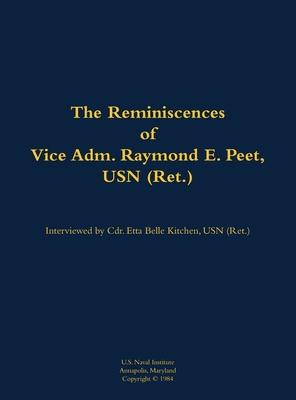Following graduation from the Naval Academy in 1942, Peet had several wartime tours in destroyers, including duty in the USS Converse (DD-509), one of the "Little Beavers" of Destroyer Squadron 23. Following postgraduate education in ordnance and duty with the Operational Development Force and Naval Proving Ground Dahlgren, Peet was gunnery officer of the USS New Jersey (BB-62) and then commanding officer of the USS Barton (DD-772). He did so well in the latter that he was tapped to become aide to the Chief of Naval Operations, Admiral Arleigh Burke. He provides a detailed description of his difficulties in working with Burke. Peet then won in a competition against Commander E.R. Zumwalt to become commissioning skipper of the first nuclear-powered destroyer, the USS Bainbridge (DLGN-25). Peet’s frequent conflict/ competition with Zumwalt crops up time and again in the oral history. Peet later served in the Office of the Secretary of Defense and was fired from his first flag assignment--the DX-DXG program--because he would not bend to the political will of his civilian seniors. Following two amphibious assignments, including one which oversaw survival training for Vietnam, Peet became director of the SecNav’s Office of Program Appraisal. As Commander First Fleet in the early 1970s, Peet experimented with the concept of operating a numbered fleet from a headquarters ashore. In his final active duty tour, Admiral Peet was Director Security Assistance Agency, concerned with foreign military sales. This memoir is candid throughout and offers interesting insights on such topics as Admiral Hyman Rickover, naval nuclear power, and the disadvantages of early promotion in the Navy.
| FindBook |
有 1 項符合
Reminiscences of Vice Adm. Raymond E. Peet, USN (Ret.)的圖書 |
 |
Reminiscences of Vice Adm. Raymond E. Peet, USN (Ret.) 作者:Peet 出版社:US Naval Institute Press 出版日期:1983-07-15 語言:英文 規格:精裝 / 588頁 / 27.94 x 21.59 x 3.18 cm / 普通級/ 初版 |
| 圖書館借閱 |
| 國家圖書館 | 全國圖書書目資訊網 | 國立公共資訊圖書館 | 電子書服務平台 | MetaCat 跨館整合查詢 |
| 臺北市立圖書館 | 新北市立圖書館 | 基隆市公共圖書館 | 桃園市立圖書館 | 新竹縣公共圖書館 |
| 苗栗縣立圖書館 | 臺中市立圖書館 | 彰化縣公共圖書館 | 南投縣文化局 | 雲林縣公共圖書館 |
| 嘉義縣圖書館 | 臺南市立圖書館 | 高雄市立圖書館 | 屏東縣公共圖書館 | 宜蘭縣公共圖書館 |
| 花蓮縣文化局 | 臺東縣文化處 |
|
|
圖書介紹 - 資料來源:博客來 評分:
圖書名稱:Reminiscences of Vice Adm. Raymond E. Peet, USN (Ret.)
|










